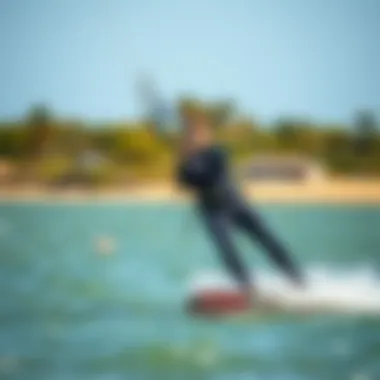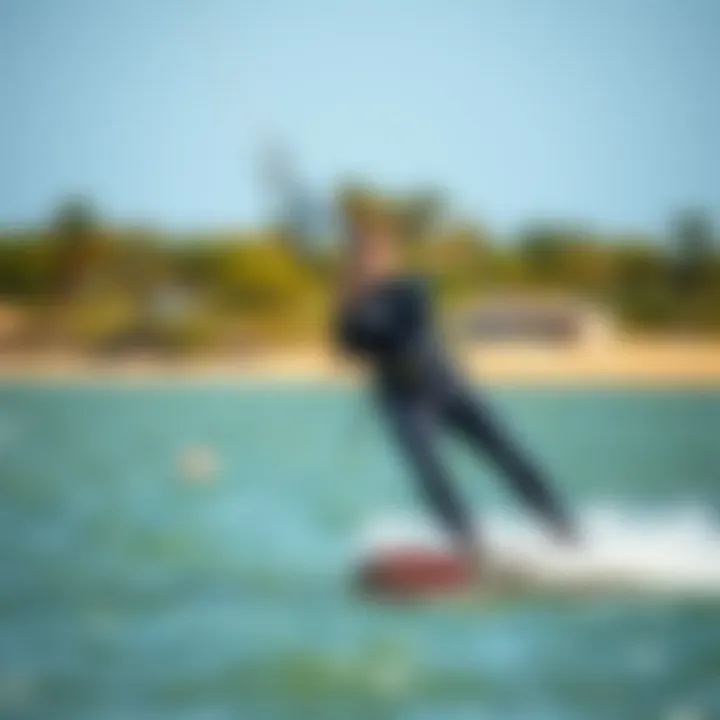Innovative Neoprene-Free Wetsuits for Water Sports


Intro
As the world becomes more aware of the environmental challenges we face, the demand for sustainable alternatives in sports gear continues to grow. Neoprene-free wetsuits are at the forefront of this movement, offering water sports enthusiasts a chance to minimize their ecological footprint without sacrificing performance. Dive in as we explore the innovations surrounding these wetsuits, focusing mainly on kiteboarding—a sport that thrives on the elements and, perhaps ironically, pushes the limits of water environments.
Kiteboarding, with its exhilarating combination of surfing and paragliding, demands equipment that not only withstands the elements but also complements the delicate ecosystems it often operates within. As such, the introduction of neoprene-free materials is significant for enthusiasts who care about sustainability. By utilizing alternative materials and design strategies, manufacturers have opened the door to performance-optimized gear that aligns with the eco-conscious ethos.
This article aims to serve as your compass in the waters of neoprene-free wetsuits, navigating through the latest innovations, benefits, and user experiences that define this new era in water sports gear. No longer are we bound to conventional materials; instead, a world of possibilities has emerged—one that celebrates both performance and environmental care.
Prolusion to Neoprene-Free Wetsuits
Wetsuits have long been essential gear for water sports, providing warmth and comfort to enthusiasts, from surfers to kiteboarders. Yet, traditional wetsuits are largely made of neoprene, a synthetic rubber that poses significant ecological concerns. This article explores the growing interest in neoprene-free wetsuits, spotlighting their sustainable alternatives and the shift towards eco-conscious water sports gear.
The importance of this discussion lies in both sustainability and performance. As awareness of environmental issues increases, many water sports enthusiasts are shifting towards conscientious choices in their equipment. Neoprene-free wetsuits offer not only an environmentally friendlier option but also an opportunity to enhance comfort and functionality.
Neoprene and Its Limitations
Understanding the limitations of neoprene is crucial. Despite being widely used, neoprene’s production involves toxic chemicals, contributing to pollution and negatively impacting the planet. Additionally, neoprene can be less breathable than its alternatives, making it uncomfortable for prolonged use. By addressing these issues, neoprene-free options can pave the way for advancements in wetsuit technology while caring for our environment. Furthermore, this shift aligns with a broader movement toward sustainability seen in various industries today.
"As we continue to surf, dive, and explore our oceans, it’s vital that our gear reflects a commitment to preserving the very environments we cherish."
This evolution in water sports gear also serves as a testament to what innovation can achieve when it's underpinned by sustainability. The recent rise of alternatives, such as natural rubber and recycled materials, signify a dive towards more responsible manufacturing practices. Understanding these innovations gives consumers valuable insights into the choices they make.
Engaging with these ideas not only influences purchasing behavior but also informs adventure enthusiasts about the latest developments in equipment. From custom fits to advanced insulation, neoprene-free wetsuits can enhance the overall experience in the water, melding performance with responsibility. Knowing what options are out there empowers users to invest wisely, choosing products that align with their values without sacrificing performance.
Materials Used in Neoprene-Free Wetsuits
The shift towards neoprene-free wetsuits has sparked significant interest in the materials utilized in this innovative water sports gear. By exploring the various alternatives, we can better understand not just their environmental benefits but also their performance attributes and user experience. The materials employed are essential not only for sustainability but also for enhancing comfort and performance for kiteboarders and other water sports enthusiasts.
Natural Rubber: An Eco-Friendly Option
Natural rubber, derived from the sap of rubber trees, serves as a commendable alternative to neoprene. This material is biodegradable, meaning that it won't linger in landfills for decades after it has reached the end of its life cycle. Natural rubber provides excellent elasticity, ensuring a snug fit, which is vital when gliding over the waves. Moreover, it possesses good insulation properties that keep users warm even in cooler waters.
While natural rubber is a strong material, it may lack some of the extreme durability that synthetic options offer. This often raises concerns for avid kiteboarders who face challenging conditions. However, manufacturers are now conducting extensive research to enhance the durability of natural rubber blends without sacrificing comfort. Furthermore, its production process tends to have a lower carbon footprint compared to conventional materials.
Recycled Plastics: Innovation in Performance
Another interesting component found in neoprene-free wetsuits is recycled plastics. Surfers and kiteboarders may already be familiar with brands incorporating materials like recycled PET (rPET) into their gear. These fabrics are often produced from post-consumer plastic bottles, which means that instead of harming the environment, these materials are repurposed into high-performance wetsuits.
The use of recycled plastics aims to reduce reliance on virgin materials while delivering the required performance for water sports. Such wetsuits often feature enhanced water repellent properties, providing not only comfort but also increasing hydrodynamics. Moreover, there is a growing trend towards blending rPET with other natural fibers, which can enhance breathability without compromising the strength necessary for navigating waves.
"The adaptation of recycled materials in wetsuit technology mirrors a broader movement within consumer industries towards sustainability while maintaining high performance."
Blends of Biomaterials for Enhanced Comfort
To take it a step further, some brands are concocting blends that combine various biomaterials, creating a fabric that offers both comfort and flexibility akin to or even superior to traditional wetsuits. These innovative blends often include plant-based materials like algae or hemp. The inclusion of these substances allows wetsuit manufacturers to harness the natural benefits of insulation and moisture-wicking, ensuring that athletes stay warm and dry during their aquatic escapades.


The mixtures crafted from these biomaterials often possess hypoallergenic properties, making them suitable for those with skin sensitivities. Additionally, while researchers focus on pushing the envelope regarding performance-related innovations, the blends often boast a softer feel against the skin, contributing to overall comfort during extended sessions on the water.
The exploration of lightweight and performance-driven materials in neoprene-free wetsuits represents a progressive step for the water sports industry, leading to more sustainable practices. These advancements call attention to the critical balance of ecological responsibility and high-quality performance, fostering a mindset that values both adventure and the environment. As we see these materials evolve, it becomes increasingly clear that conscious choices in gear can have a lasting impact on our waters. The future of wetsuits, it seems, is bright.
Benefits of Neoprene-Free Wetsuits
The shift towards neoprene-free wetsuits marks a significant moment in the evolution of water sports gear. With a growing awareness of environmental issues and the push for sustainability, these wetsuits present advantageous features that both the planet and the user can appreciate. Here, we will delve into several compelling benefits, such as their reduced environmental impact, enhanced comfort and fit, and superior temperature regulation characteristics. Understanding these elements allows consumers to make informed decisions when selecting equipment that aligns with both performance needs and ethical considerations.
Reduced Environmental Impact
Neoprene production is notorious for its contribution to environmental degradation. The material is derived from petroleum, which not only strains our fossil fuel reserves but also involves toxic chemical processes that can contaminate water sources and harm ecosystems. In contrast, neoprene-free wetsuits are often crafted from more sustainable materials such as natural rubber and recycled plastics. These materials generate less waste during production, translating to a smaller carbon footprint overall.
"The future of water sports should be in harmony with nature, not at its expense."
Choosing neoprene-free wetsuits helps reduce plastic pollution. Many brands utilize recycled materials sourced from discarded plastics, thus giving old materials a new life and reducing the need for virgin resources. Additionally, the manufacturing processes for these suits often prioritize eco-friendliness, further minimizing their environmental toll. The lifestyle surrounding water sports doesn’t have to come at an ecological cost, and neoprene-free wetsuits are paving the way for greener alternatives.
Improved Comfort and Fit
Comfort is a non-negotiable when it comes to choosing suitable wetsuits for a day in the water. Neoprene-free options are designed with comfort in mind, catering to various body shapes and sizes. They tend to offer a snug fit due to the elasticity of natural rubber, which allows for ease of movement without feeling overly constrictive.
Many users report that these suits feel lighter, providing a more liberating experience while kiteboarding or engaging in other water sports. The absence of neoprene means that users are less likely to experience irritation or chafing, a common issue with traditional wetsuits.
Furthermore, innovative designs incorporate seamless construction and customizable features. This attention to detail allows each user to find their perfect fit, enhancing their overall experience. Improved comfort translates to longer durations spent on the water, enriching the overall enjoyment of various water sports activities.
Temperature Regulation Characteristics
Another standout feature of neoprene-free wetsuits is their advanced temperature regulation capabilities. Traditional neoprene can trap excessive heat, creating an uncomfortable environment inside the suit. Neoprene-free alternatives, however, are engineered to promote greater breathability and moisture management.
Materials such as merino wool blends or specially designed thermal fabrics help balance temperature by maintaining warmth when necessary while allowing excess heat to escape. This is crucial for those who spend extended periods in changing water temperatures.
Users have noted that neoprene-free wetsuits provide exceptional thermal regulation, proving effective in both warm and cool conditions. Ensuring that sports enthusiasts stay comfortable contributes immensely to their performance and enjoyment in the water.
In summary, the benefits of neoprene-free wetsuits are multifaceted. They serve as a testament to the willingness of the water sports community to embrace sustainable practices without sacrificing comfort or functionality. As we navigate an increasingly eco-conscious world, these innovations will likely shape the future of water sports gear.
Challenges and Considerations
As the conversation around sustainable products evolves, the emergence of neoprene-free wetsuits raises essential challenges and considerations for both consumers and manufacturers. While these innovative alternatives provide an eco-friendly option for water sports enthusiasts, consumers might encounter hurdles that are not so obvious at first glance. The importance of addressing these elements lies in fostering informed choices, enhancing product development, and navigating the marketplace effectively.
Durability Compared to Traditional Wetsuits
One of the primary concerns that water sports enthusiasts grapple with is the durability of neoprene-free wetsuits compared to their traditional counterparts. Neoprene is lauded for its resilience and ability to withstand wear and tear over time. However, some naturally derived materials or recycled components, while sustainable, may not exhibit the same longevity. Recent advancements have led to the development of blends that enhance durability while maintaining the eco-friendly ethos.
- Natural rubber, for instance, tends to be more flexible but could wear faster in harsh conditions.
- Recycled plastics may offer startlingly remarkable tensile strength, but users might find them stiffer initially.


So what does this mean for you? A wetsuit that can handle extreme conditions while still being gentle on the environment is highly sought after, but beware! It’s essential to check product reviews or talk to fellow adventurers who’ve taken the plunge. You might find some brands standing out for their robust design despite using sustainable materials.
"Sustainability should not come at the cost of performance; we need gear that works and protects our planet."
— Water Sport Expert
Cost Implications for Consumers
Now, let’s chat about the elephant in the room — cost. It seems straightforward; new technology and sustainable materials often come at a premium. While traditional neoprene wetsuits can range widely in price, neoprene-free alternatives frequently carry a heftier price tag due to the innovative materials and research involved in their production. For budget-conscious kiteboarders or travelers, this can pose a significant barrier.
On the flip side, investing in a quality neoprene-free wetsuit can prolong your gear’s lifespan significantly, potentially saving you money in the long run. Individuals should carefully evaluate whether the upfront investment aligns with their usage patterns, especially if they frequent high-stakes water environments.
- Considerations to keep in your back pocket:
- How often do you participate in water sports?
- Do you demand performance in extreme conditions where durability also matters?
- Would you mind spending a bit more now for a sustainable future?
Availability and Market Acceptance
Last but not least, we can’t overlook the question of availability and market acceptance. As consumers express increased interest in sustainable practices, manufacturers are stepping up to the plate, yet availability can still be spotty. Certain brands have adopted neoprene-free designs, but the selection is not as extensive as for traditional wetsuits. It can become frustrating when you’re ready to snag that perfect wetsuit, realizing it's available only in limited sizes or colors.
The growing trend toward sustainability indicates that companies will likely ramp up production over time. As awareness of the environmental impact of neoprene spreads, we can expect more models to hit the racks. However, it’s crucial for potential buyers to stay informed.
- Tips for consumers:
- Check reviews online or look at forums like Reddit for real-user experiences.
- Visit manufacturers' websites for upcoming releases.
- Engage with your community to share insights and recommendations.
In summary, as you navigate the waters of choosing a neoprene-free wetsuit, weighing these challenges and considerations can empower you to make more informed purchasing decisions. Embrace these innovations while keeping an eye on durability, budgetary impacts, and the necessary market adaptations, and you may just find the perfect balance between performance and sustainability.
User Experiences with Neoprene-Free Wetsuits
Exploring the user experiences with neoprene-free wetsuits offers valuable insights into how these innovations are shaping the world of water sports. For many enthusiasts, the transition from traditional neoprene to more sustainable alternatives represents not only a shift in the materials used but also in the overall experience of using these suits. It's crucial to understand different perceptions and feedback as they reveal the practical aspects that come with this new gear.
Insights from Kiteboarding Enthusiasts
Kiteboarding enthusiasts often serve as a litmus test for new gear, as they demand high performance under varying conditions. Feedback from this active community indicates a growing acceptance of neoprene-free options. Many kiteboarders appreciate that these suits tend to offer greater flex and movement in the water, allowing for more dynamic maneuvering on the board.
A kiteboarder named Sarah mentioned, "I made the leap to a neoprene-free wetsuit last summer and haven’t looked back. I feel less constricted, which makes jumping and tricks easier. Plus, I’m happy knowing my gear is more eco-friendly!" This sentiment reflects a broad trend within the community: the desire for performance enhancements coupled with responsible environmental choices.
Other kiteboarders have noted the enhanced breathability and temperature regulation of these new materials. Unlike traditional neoprene, which can sometimes feel suffocating or causing overheating, many of the newer fabrics allow for better airflow, ultimately resulting in a more comfortable experience on the water.
Reviews of Leading Brands
When it comes to specific brands, positive experiences are being reported across the board. The market has seen innovative entries from companies like Patagonia, which has made headlines with its Yulex wetsuit, crafted from natural rubber. Users have praised it for warmth and flexibility, noting that it's comparable to traditional options but without the harmful environmental impact associated with conventional neoprene production.
Another noteworthy player is the company NRS, known for utilizing recycled plastics in their designs. Feedback on their products highlights durability alongside comfort. One user stated, "I expected less durability with recycled materials, but this wetsuit has held up beautifully through the rigors of kiteboarding."


Key Insights from Reviews:
- Performance: Enhanced flexibility and comfort during activities.
- Eco-Friendliness: Strong appreciation for brands focusing on sustainable materials.
- Durability: Users report that many neoprene-free options perform well over time, matching or exceeding the lifespan of traditional suits.
In summary, the experiences shared by kiteboarding enthusiasts and the reviews of leading brands collectively emphasize a significant shift. Those who are stepping away from neoprene are finding not only satisfying performance but also a sense of contributing to sustainability efforts in the water sports industry. This evolution could very well shape purchasing trends and design innovations in the near future.
Future Trends in Wetsuit Manufacturing
The wetsuit industry is not just about keeping warm anymore; it's a dynamic mix of fashion, technology, and sustainability. As we face environmental challenges, the movement towards neoprene-free wetsuits signals a significant shift. Understanding the future trends in wetsuit manufacturing is crucial for every kiteboarder and water sports enthusiast. It's about discovering how emerging technologies can not only enhance performance but also mitigate the impact on our oceans and ecosystems.
Emerging Technologies and Innovations
The shift away from traditional neoprene has paved the way for new technologies that are altering the landscape of water sports gear. One notable innovation is the development of bio-based and synthetic materials that replicate or exceed the qualities of neoprene. For instance, some brands are now experimenting with plant-derived materials such as Yulex, which is derived from rubber trees. This offers durability while significantly reducing carbon footprint compared to oil-based counterparts.
Moreover, advancements in weaving techniques have led to lighter and more flexible designs. These new suits use micro-perforations and advanced stitching methods for better breathability and mobility. It’s fascinating how brands are utilizing computer-aided designs to create wetsuits specifically tailored to the body’s contours, minimizing drag and maximizing comfort. Here are a few key technologies currently making waves in the industry:
- 3D Printing: Prototyping wetsuits using 3D technology allows for rapid testing and customization. This reduces waste and improves design precision.
- Smart Fabrics: Research is ongoing into fabrics that can adjust thermal qualities based on water temperature, making them adaptable for various conditions.
- Biomimicry: Drawing inspiration from nature—think of shark skin—certain wetsuits are now designed to reduce water resistance.
"Innovation in wetsuit materials is akin to the evolution of a kiteboarder—adapt, refine, and perform better in sync with the environment.”
As technologies continue to develop, understanding these innovations will empower adventurers to choose equipment that performs impeccably while aligning with a sustainable ethos.
The Role of Consumer Demand in Development
Consumer demand is a driving force in the evolution of wetsuit manufacturing. As awareness about environmental issues grows, enthusiasts are increasingly favoring eco-friendly alternatives. Brands that ignore this trend risk being left behind. Feedback from kiteboarders, travelers, and other water sports aficionados is crucial; it shapes the features and functionality that modern wetsuits must offer.
This shift towards sustainability has also ignited competition among manufacturers. They now strive to create not just more comfortable and high-performing gear but also to showcase their commitment to preserving the environment. Key points include:
- Transparency: Consumers are keen on knowing where materials come from and how they are produced. Brands that can demonstrate ethical sourcing gain trust.
- Customization: With advances in technology, users want options and personalization. Customized fits that cater to diverse body types are increasingly in demand.
- Community Engagement: Brands that invest in communities—through beach clean-ups or educational programs—often resonate better with consumers.
Navigating this landscape requires brands to be both innovative and responsive to consumer desires. The future of wetsuit manufacturing will likely see a growing emphasis on eco-friendliness matched with performance tweaks that cater to the ever-evolving needs of water sports enthusiasts.
As we look ahead, it’s evident that the confluence of technology and consumer preferences will shape the next generation of wetsuits, leading to improved experiences on the water while respecting our natural resources.
Closure: The Evolving Landscape of Wetsuits
As the awareness around environmental sustainability grows, the demand for neoprene-free wetsuits is becoming increasingly significant. In this article, we have traversed the latest innovations in water sports gear and the valuable alternatives that await adventurers in the waves. The shift away from traditional neoprene not only addresses ecological concerns but also introduces options that can enhance the user experience—offering excellent performance without a hefty impact on our planet.
Implications for the Water Sports Industry
The rise of neoprene-free wetsuits carries profound implications for the water sports industry. By opting for sustainable materials, manufacturers are not just adapting to a greener approach. They are redefining what it means to create performance-oriented gear. For instance, brands that embrace natural rubber or recycled plastics are able to cater to eco-conscious consumers while providing products that meet rigorous performance standards.
- Market Differentiation: Companies stand to differentiate themselves through their commitment to sustainability. Unique selling points centered on environmental responsibility can attract a loyal consumer base that favors ethical practices.
- Regulatory Pressures: As governments and organizations push for more stringent environmental regulations, companies that have already made the leap to sustainable alternatives will likely be in a stronger position in the long run.
- Collaboration and Innovation: There’s an emerging trend of collaboration among companies, scientists, and environmentalists aimed at developing next-gen materials. The industry could see a wave of innovations, with more brands focusing on eco-friendly production methods.
"The water sports industry is at a crossroads, choosing between the comfort of tradition and the demands of future sustainability."
Encouraging Sustainability in Outdoor Sports
Encouraging sustainability in outdoor sports transcends the mere production of eco-friendly equipment. It also involves fostering a culture where athletes and recreational enthusiasts recognize their role in protecting natural resources. Education and awareness around the benefits of sustainable practices can inspire larger movements within water sports communities.
- Community Initiatives: Groups can engage in beach clean-ups or awareness campaigns, emphasizing the importance of maintaining clean and healthy aquatic environments. Local clubs could even partner with manufacturers producing neoprene-free options to highlight their products.
- Advocacy and Outreach: Organizations might push for more transparency in manufacturing processes. Consumers have the right to understand where their gear comes from and how it affects the environment. Advocating for certifications can ensure that companies stay true to sustainable practices.
- Sustainable Tourism: By choosing eco-friendly wetsuits, travelers can contribute to sustainability while enjoying their adventures globally. This choice reflects a growing appreciation for protecting the very places that bring joy to surfing, kiteboarding, and swimming.















